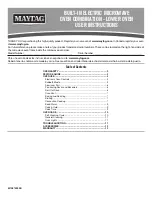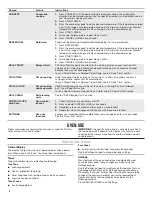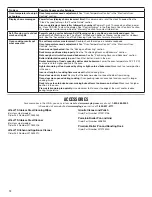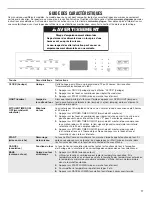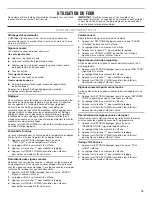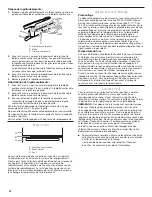
7
Closed and Engaged Position
To Remove Roll-Out Rack:
1.
Slide the rack in completely so that it is closed and engaged
with the sliding shelf.
2.
Using 2 hands, lift up on the front edge of the rack and the
sliding shelf together. Slowly push rack and sliding shelf to the
back wall of the oven so the front edge of the sliding shelf sits
on the rack guides located on the sides of the oven.
The front edge of the rack and the sliding shelf should be
higher than the back edge.
3.
Using 2 hands, lift up on the front edge of the rack and sliding
shelf together.
4.
Pull out the rack and sliding shelf.
To Replace Roll-Out Rack:
1.
Using 2 hands, grasp the front of the closed rack and the
sliding shelf. Position the closed rack and the sliding shelf
on the rack guide.
2.
Using 2 hands, lift up on the front edge of the rack and the
sliding shelf together.
3.
Slowly push the rack and the sliding shelf to the back of the
oven until the back edge of the rack pulls over the end of the
rack guide.
To avoid damage to the sliding shelves, do not place more than
25 lbs (11.4 kg) on the rack.
Do not clean the roll-out extension rack in a dishwasher. It may
remove the rack’s lubricant and affect its ability to slide.
See the “General Cleaning” section for more information.
Oven Vent
The oven vent should not be blocked or covered since it allows
the inlet of fresh air into the cooling system. Also, the bottom
vent should not be blocked or covered since it allows the inlet of
fresh air into the cooling system and the outlet of hot air from the
cooling system. Blocking or covering vents will cause poor air
circulation, affecting cooking, cleaning, and cooling results.
B
A
A. Slide rails
B. Sliding shelf
B
A
C
A. Slide rails
B. Rack
C. Sliding shelf
B
A
C
A. Control panel
B. Oven vent
C. Oven
Baking and Roasting
Preheating
When beginning a Bake cycle, the oven will begin preheating
after START LOWER is pressed. The oven will take approximately
13 to 19 minutes to reach 350°F (177°C) with all of the oven
racks provided with your oven inside the oven cavity. Higher
temperatures will take longer to preheat. The preheat cycle rapidly
increases the oven temperature. The actual oven temperature
will go above your set temperature to offset the heat lost when
your oven door is opened to insert food. This ensures that when
you place your food in the oven, the oven will begin at the proper
temperature. Insert your food when the preheat tone sounds. Do
not open the door during preheat before the tone sounds.
Oven Temperature
While in use, the oven elements will cycle on and off as needed
to maintain a consistent temperature, but they may run slightly
hot or cool at any point in time due to this cycling. Opening the
oven door while in use will release the hot air and cool the oven
which could impact the cooking time and performance. It is
recommended to use the oven light to monitor cooking progress.
Before baking and roasting, position racks according to the
“Positioning Racks and Bakeware” section. When roasting, it is
not necessary to wait for the oven preheat cycle to end before
putting food in unless it is recommended in the recipe.
Broiling
When broiling, preheat the oven for 5 minutes before putting food
in unless recommended otherwise in the recipe. Position food
on grid in a broiler pan, and then place it in the center of the oven
rack. Close the oven door to ensure proper broiling temperature.
NOTE:
Odors and smoke are normal the first few times the oven
is used or if the oven is heavily soiled.
Changing the temperature when broiling allows more precise
control when cooking. A lower broil setting causes cooking to
occur slower. Thicker cuts and unevenly shaped pieces of meat,
fish, and poultry may cook better at lower broil settings. Place the
food in the upper or lower oven. Refer to the “Positioning Racks
and Bakeware” section for more information.
On lower settings, the broil element will cycle on and off to
maintain the proper temperature.
■
For best results, use a broiler pan and grid. It is designed
to drain juices and help avoid spatter and smoke.
If you would like to purchase a broiler pan, one may be
ordered. Please refer to the “Accessories” section for
more information.
Convection Cooking
During convection cooking, the fan provides hot air circulation
throughout the oven. The movement of heated air around the
food can help to speed up cooking by penetrating the cooler
outer surfaces. Food cooks more evenly, browning and crisping
outer surfaces while sealing moisture inside.
During the Convect function, the ring element, bake and broil
elements, and the fan operate to heat the oven cavity. If the oven
door is opened during convection cooking or preheating, the
fan turns off immediately and the element(s) will turn off after
30 seconds. Once the door is closed, the element(s) will turn
back on.
NOTE:
It is normal for the convection fan to run during non-
convection cycles as well as during preheat.
■
It is important not to cover foods so that surface areas remain
exposed to the circulating air, allowing browning and crisping.
■
Keep heat loss to a minimum by only opening the oven door
when necessary. It is recommended to use the oven light to
monitor cooking progress.
■
Choose cookie sheets without sides and roasting pans with
lower sides to allow air to move freely around the food.
■
Test baked goods for doneness a few minutes before the
minimum cooking time with a method such as a toothpick.

